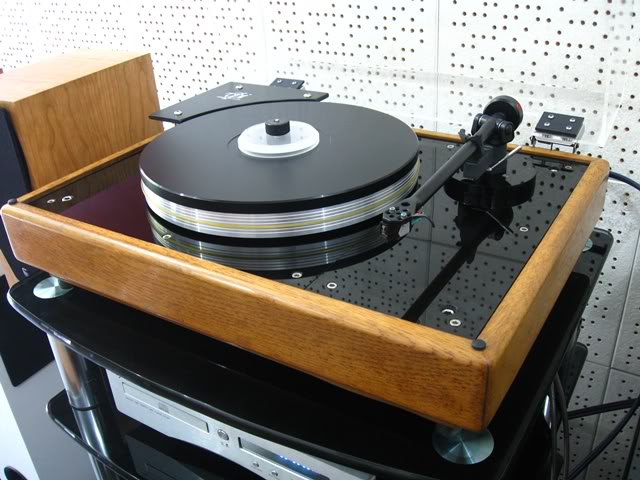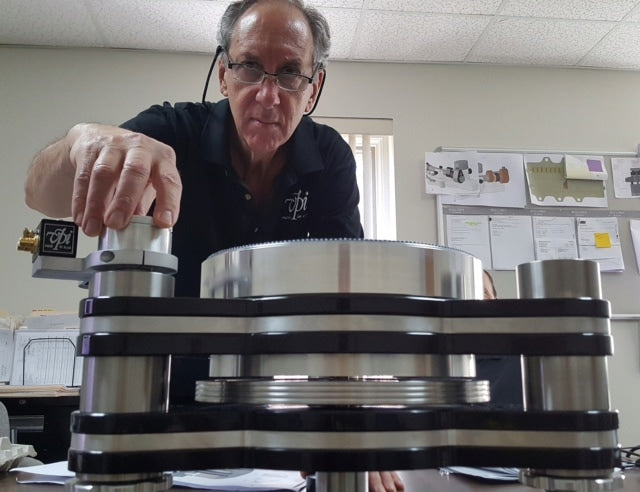
Harry Weisfeld with the Titan
VPI founder Harry Weisfeld was a lifelong audiophile when he met HP at an audio dealership, and a friendship ensued. In 1976, Harry visited the infamous HP manse in Sea Cliff, New York, and after a startling before/after demo, came to covet a record cleaning machine made by the English company, Keith Monks. Problem was, it was a lot of money, $1700 ($7195 in 2016 bucks), more than the newlywed Harry could justify paying. (It was also notoriously fragile, finicky, expensive to maintain and prone to break down—but that’s another story.)
At that time, Harry was an engineer and sheet-metal contractor, working on the construction of some major NYC buildings. As is the case of many in audio, he was also a racer, drag-racing and maintaining a Hemi-powered Dodge. So: he had skills, and knew how to design and make things, or get them made.
VPI Industries’ first products were record weights and a turntable isolation base similar to the one made by Mitchell Cotter. After considerable experimentation, Harry W. took the prototype of his cleaning machine to Harry P., who pronounced it better than the Keith Monks—at a projected price of 20% that of the English unit. The VPI unit was noisy, but it worked well, and was stable and relatively bulletproof.
The cleaning machine was dubbed the HW-16, and is still in production. Most of the original production run from the late ‘70’s and early ‘80’s is still in use, relentlessly de-gunking records. The “Magic Brick” appeared soon after, a hefty wooden block filled with steel plates, designed to provide physical damping to components while simultaneously absorbing stray flux. Despite the skepticism the Brick provoked, it worked, and worked well—enough so that the company is in the process of reviving it as a product.
The company’s first turntable, the HW-19, remained in production for many years, and was updated into Mk. 2, 3, and 4 versions. The upgradability of the HW-19 became an earmark of subsequent VPI products, allowing an entry-level product to be improved to near-top-line performance. The TNT followed, Weisfeld’s first venture into state-of-the-art territory. It, too, remained in production for many years, accommodating a number of updates and improvements.

VPI’s first turntable, the HW-19
The company began selling products internationally in 1980, and Harry was able to devote all his time to VPI, along with wife Sheila, in 1983. The Weisfeld’s first son, Jonathan, was born in 1978; second son Mathew was born in 1985. Sadly, Jonathan was killed in a car accident with two other boys in 1995. He had been working with his father on a tonearm design,which was released after Jonathan’s death as the JMW Memorial Tonearm. Co-founder Sheila passed away from cancer in 2011, and son Mat made his first CES appearance for the company a month later, in January, 2012.
Clearly, there have been upheavals during the time of the company’s existence, both in the world of LPs and in the Weisfeld family. At a late-‘80’s CES, during the rise of CDs and digital audio, a fellow manufacturer asked Harry what he was going to do in five years—presuming that the market for records and playback gear would be nothing but a memory by then.
“I dunno,” said Harry. “I’ll think of something.”
As it turned out, all Harry had to do was keep on keeping on: as others exited the market, VPIs share of the shrinking market grew. When the market grew, as it has over the past decade, the company was well-positioned with a familiar name, a history of technical innovation, and durable, upgradable products—and business boomed.
Son Mat was a high-school technology teacher at the time of his mother’s death, and for a while, split his time between teaching and working at VPI. In fairly short order, Mat went full-time at VPI, and was named President of the company by Harry…who promptly retired.

Mat Weisfeld
In the past few years, Mat has introduced a string of new models, showing his own particular style with the Nomad, Traveler, Player, Prime, Avenger, and others. It’s hard to keep up.
Harry has been busy during his retirement. Annoyed at the proliferation of gigantic, Rube Goldberg-esque turntables with six- and seven-figure price tags, he designed the massive Titan, promising state-of-the-art performance at a fraction of the cost of those other units. $48,000 is by no means chump change, but the combination of rim-drive, magnetic coupling, extensive multi-level isolation, multiple arm bases and an all-new, all-analog speed control unit is clearly not cheap to make.
Says the man who has likely heard and owned every credible turntable ever made, “It’s the first turntable I’ve ever heard that sounds like reel-to-reel tape.” Harry owns seven reel-to-reel decks and is contemplating building his own…so that’s quite a statement.
Meanwhile, Mat Weisfeld and new wife Jane are ready to take the second generation —and third?— of VPI to even greater heights. Knowing Harry, his “retirement” will consist of more than playing golf!



